Scientists say they’ve found a molecular kill switch that when activated destroys cancer cells. According to new research, microRNA can be used to send cancerous cells a self-destruct message which they cannot ignore. By incorporating this mechanism into a new treatment, it could be possible to rid the body of cancer without having to go through the pain of chemotherapy.

Cells are always created and destroyed in the human body. About 300 million cells die every minute in our bodies and are replaced with new ones. This is to protect the body against potentially malfunctioned aging cells or diseased cells. The problem is that cancer cells can survive because they have the ability to ignore the immune system’s self-destruct instructions. But that doesn’t necessarily mean that there’s no way to relay this message to cancer cells.
Previously, researchers at Northwestern University described a mechanism by which every cell in the body can be programmed for destruction. Now, the same research team has reported that they’ve managed to crack the ‘code’ required to initiate this sequence.
Writing in the journal Nature Communications, the authors reported that the instructions of cell death are available as information in ribonucleic acid (RNA) and in microRNAs. Specifically, they used small-interfering (si)RNAs to trigger toxicity in cancer cells, a process normally activated by chemotherapy. Before they arrived at the winning formula consisting of six nucleotides (6mers) present in small RNAs, the researchers tested 4,096 different combinations of nucleotide bases.
The molecules used in the study put stress on several genes in cancerous cells, initiating the self-destruct sequence for four tested human and mouse cell lines. Because the molecules simultaneously destroy multiple genes that the cells need to survive, the cancer is unable to develop resistance.
“Now that we know the kill code, we can trigger the mechanism without having to use chemotherapy and without messing with the genome. We can use these small RNAs directly, introduce them into cells and trigger the kill switch,” said lead author Marcus E. Peter, professor of cancer metabolism at NU Feinberg School of Medicine.
In 2018, an estimated 1,735,350 new cases of cancer will be diagnosed in the United States and 609,640 people will die from the disease. The most common cancers (listed in descending order according to estimated new cases in 2018) are breast cancer, lung and bronchus cancer, prostate cancer, colon and rectum cancer, melanoma of the skin, bladder cancer, non-Hodgkin lymphoma, kidney and renal pelvis cancer, endometrial cancer, leukemia, pancreatic cancer, thyroid cancer, and liver cancer.
To treat cancer, doctors usually turn to chemotherapy with one or more cytotoxic antineoplastic drugs. The problem with chemotherapy is that it leads to horrible side effects because it also damages healthy cells.
By incorporating the molecular messengers identified by the new study into a new therapy, researchers hope to rid patients of cancers without having to deal with chemo’s debilitating side effects. It may take many years before this happens, but the promising results suggest that one-day cancer could be treated safely.






